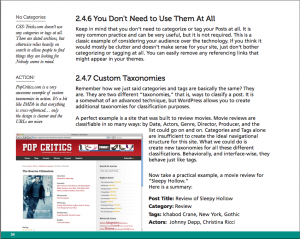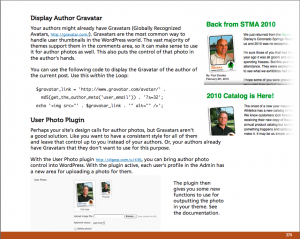 A couple of weeks ago, I won an eBook version of Digging Into WordPress from a giveaway on Twitter. This book was authored by Chris Coyier and Jeff Star, who are both successful WordPress developers, well known in the community. I spent some time looking over it, And wanted to share my impressions. If you’re in a hurry and just want the 5-second review: It’s good, and it’s got something for beginners and experts alike. If you want a more in-depth look, then please read on.
A couple of weeks ago, I won an eBook version of Digging Into WordPress from a giveaway on Twitter. This book was authored by Chris Coyier and Jeff Star, who are both successful WordPress developers, well known in the community. I spent some time looking over it, And wanted to share my impressions. If you’re in a hurry and just want the 5-second review: It’s good, and it’s got something for beginners and experts alike. If you want a more in-depth look, then please read on.
The first thing you’ll notice about this book: it’s gorgeous. These guys are both designers, and their aesthetic carries though in this work. The typography is refreshing, they make good use of color, there are screenshots where appropriate, and accent graphics add flair, but are not overdone.
You might also notice that it’s over 400 pages long. There are 11 chapters, covering everything from installation to customizing themes, to security. If you’d like to get a taste, Chapter 3, Anatomy of a WordPress Theme, is available for download (the sample PDF also includes the full table of contents for the rest of the book). This chapter covers the usage of the standard template files which a theme can incorporate, the hierarchy for various page views, the Loop, sidebars, footers, and widgets, among other things. And that’s not the end of theme information — there’s more in Chapter 4, which discusses how to customize the loop, archive pages, tag clouds, and child themes.
Other chapters cover topics such as SEO, plugins, creating custom feeds, analytics, and how to create and use custom taxonomies. The information is thorough and well presented, with lots of screenshots and code examples sprinkled throughout. The ZIP file for the eBook also includes several example themes which can be used to jumpstart your own theming experiments.
Throughout the book, there are plenty of links to useful plugins, themes, and other resources and websites. One minor niggle is that all of the links are given as shorturls through the digwp.com server. On the one hand, I would prefer to see the actual link, so that I know ahead of time whether it’s a site that I’ve visited before, or some new site that I might like to visit. But on the other hand, I understand that this was done for the purpose of making it easier to format the text without having to wrap long URLs. I would suggest that in the future, they might consider using the shorturls in the main text, with footnotes to provide the full versions.
Currently, the print edition is sold out. They are exploring options for printing more copies, so hopefully they will come up with a reasonable way to make more hardcopies soon. I am one of those people who generally prefers printed books to eBooks. But I have to say that the PDF version (which currently sells for $27) does not disappoint, and I really didn’t mind reading it on the screen too much. Plus, once you’ve purchased it, you get free updates in the future when they revise it. And with the recent release of WordPress 3.0, there will probably be an update soon (the book currently covers up through WordPress 2.9).
All-in-all, I highly recommend Digging Into WordPress for anyone who wants to learn how to configure and customize WordPress. It will be most useful to intermediate users who might already be familiar with general use, but would like to learn more advanced ways to tailor their sites. But the book covers a lot of ground, and even experts might pick up a thing or two.
Disclaimer: The links this article are affiliate links. If you follow them and purchase the book, I will receive a portion of the sale. However, this did not color my review. I had already formed my opinions before discovering the affiliate program.


Pingback: Tweets that mention https://dougal.gunters.org/blog/2010/06/29/book-review-digging-into-wordpress?amp=&=utm_sourcepingback -- Topsy.com
Pingback: Tweets that mention Book Review: Digging Into WordPress -- Topsy.com
Pingback: Dougal Campbell’s Blog: Book Review: Digging Into WordPress | Development Blog With Code Updates : Developercast.com